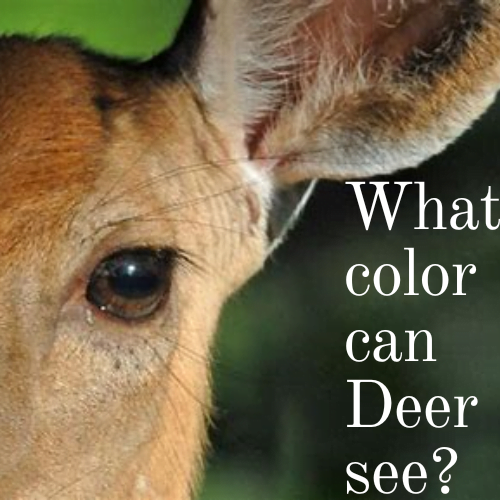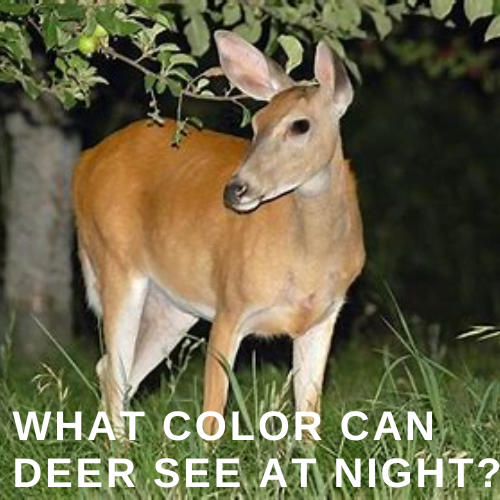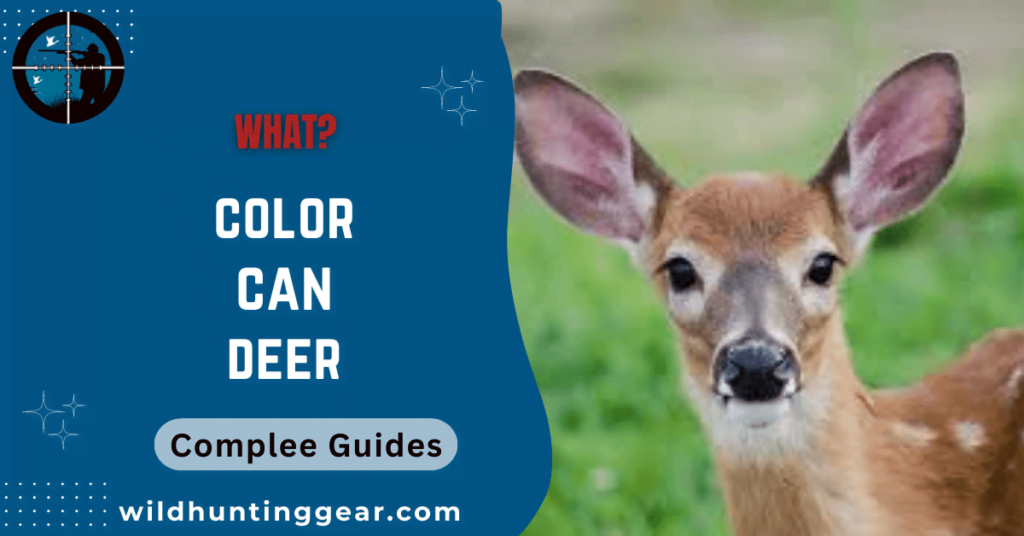Deer are graceful creatures they’re beautiful and have a unique set of skills when it comes to surviving in the wild. One question that many people ask about deer is what color can they see? This is an interesting topic to explore, as different wildlife species have different capabilities when it comes to seeing colors.
For the avid hunter or nature enthusiast, understanding this particular topic can give you a better insight into which strategies work best when hunting or observing deer in their natural habitat.
In this blog post, we’ll explore the recent research into what color deer can see and just how far their visual spectrum reaches. We’ll also discuss some interesting facts related to deer vision.
So if you’re curious about how exactly vision works for one of nature’s most beloved animals keep reading!
Related : Deer Hunting Rangefinders
Understanding the basics of deer color vision

Deer, like many mammals, have color vision, although it differs from human color vision in some ways.
Here are the basics of color vision in deer:
- Color Perception: Deer have dichromatic color vision, which means they have two types of color-sensitive cone cells in their eyes. These cone cells are responsible for detecting and distinguishing different colors. The two types of cone cells in deer are sensitive to blue and green wavelengths of light.
- Adaptations: Deer have some adaptations that allow them to better perceive color and movement in low light conditions. For example, their eyes contain a special pigment called tapetum lucidum, which reflects light back into their retinas to increase the level of light detection.
These adaptations help deer detect movement and colors in very low light conditions, such as during dawn or dusk when hunting is most successful.
- Color Processing: Deer process color information in their retinas in a similar way to humans but their retinas have fewer cone cells than ours. This means that the colors they detect may appear muted or dulled compared to what humans see.
- Ultraviolet Sensitivity: Deer have an additional advantage in their color vision – they are sensitive to ultraviolet (UV) light. While humans cannot see UV light, deer can detect it. This ability allows them to perceive UV-reflecting patterns on plants and animals, which can be helpful in locating food sources, identifying predators or recognizing other deer.
By understanding the basics of deer color vision, you can gain a better understanding of how they perceive their environment.
What color can deer see?
Based on research and studies, it is generally believed that deer have good sensitivity to short-wavelength light. They can distinguish between blues, greens, yellows, oranges, reds and violets. Deer can also differentiate between different shades of gray or brown, which they use to recognize predators such as coyotes and wolves. By combining color vision with their keen sense of smell, deer are able to effectively survive in the wild.

However, their ability to perceive longer-wavelength light, such as red and orange, is thought to be limited. They may perceive these colors as shades of brown or gray.
Additionally, deer most likely have difficulty distinguishing between colors in low light conditions. In the dim light, they rely heavily on their sharp senses of smell and hearing to detect potential danger.
Given the varying levels of color perception among different species of deer, it is difficult to pinpoint a single answer to this question.
What colors can deer see at night?

Deer have a type of color vision that is best suited for detecting movement and perceiving their environment in low-light conditions, such as during dusk or dawn.
While they cannot see colors in the same way humans do, they are not completely colorblind. They are able to perceive light but they cannot distinguish colors at night.
However, deer may be able to distinguish between shades of gray and brown better than other colors at night. Deer also use their keen sense of hearing and smell to detect predators or potential threats in the dark. In addition, deer can use their white tails to signal danger and warn other deer of impending danger.
It’s important to note that the exact range of colors that deer can perceive at night is not fully understood, as research on this topic is limited. However, their vision is optimized for low light and they rely on other senses.
Factors influence deer vision
Deer have excellent vision which is largely influenced by the environment they live in.
- Light Levels: Deer typically adapt to their environment by having large pupils that can adjust to different light levels. This helps them stay alert and aware of their surroundings, particularly when they are out in open fields at night.
Deer are most active during twilight hours and near dawn or dusk when light levels are low. Low light levels also help deer detect movement more easily – a great asset for avoiding predators.
- Color Saturation: Deer eyes are very sensitive to color saturation, so they can distinguish between brighter colors like reds and oranges and duller colors like browns and grays. This helps them identify potential food sources, as well as predators, more quickly.
- Water Availability: Since deer rely on water for survival, it’s important that they are able to detect where the nearest water source is located. They use their eyes to pick up on subtle cues in the environment such as the presence of water or changes in vegetation. By doing so, they can find the best location to quench their thirst.
- Environmental factors: Deer vision is also affected by environmental factors such as weather, humidity and temperature. For instance, heavy fog may reduce a deer’s ability to see clearly. Similarly, bright sunlight or intense heat can cause glare that makes it difficult for deer to distinguish objects in their surroundings.
Overall, deer have an excellent vision which enables them to recognize potential threats and take advantage of food sources quickly. By understanding the colors that deer see best and worst, hunters can use their knowledge to improve their success when out in the field.
Some interesting facts related to deer vision
- Deer have a panoramic vision, able to see up to 310 degrees. This gives them a wider view than human eyes, which can only see up to 180 degrees.
- Their superior peripheral vision helps them detect predators and other dangers from a distance.
- They also have excellent night vision due to a special layer of tissue in their eyes, called the tapetum lucidum. This layer reflects light back into the eye, allowing them to see in low-light conditions.
- In addition to panoramic vision and night vision, deer also have a sharp sense of smell and hearing that helps them detect predators and other threats.
- Deer’s vision is also incredibly fast, allowing them to process visual information quickly and accurately. This helps them react quickly to danger or potential opportunities.
- Their eyes are also highly sensitive to color, which helps them identify food sources and other objects in their environment.
- Finally, deer have a remarkable ability to focus on objects up close as well as at a distance. This helps them spot predators and other potential threats while also allowing them to search for food.
By understanding the incredible vision capabilities of deer, we can better understand their behavior in the wild and develop more effective strategies for protecting them.
How to use color to your advantage when hunting?
1) Choose clothing that is easily visible: Avoid wearing dull colors like brown and green, which are not as noticeable to deer. Instead, opt for bright orange or yellow hues that will stand out against the background of your hunting area.
2) Use camouflage strategically: While camouflage may hide you from other hunters, it can be a disadvantage if you’re trying to stay hidden from deer. Use camouflage in combination with brighter colors, such as orange accents or reflective tape. This will help you remain visible to deer while blending into your surroundings.
3) Make sure your scent doesn’t give you away: Scent is one of the strongest tools that deer have for detecting predators, so make sure that you don’t give away your position by wearing scented clothing or using scented products.
4) Pay attention to the light levels: Deer are most active during low light conditions, so plan your hunting trips accordingly and adjust your clothing and gear accordingly.
5) Observe deer behavior: Take note of how deer move around in their habitat. This can help you understand their behavior and gain insight into what they are able to see or detect.
By understanding the characteristics of deer vision, hunters can use color and other strategies to their advantage when out in the field. By taking simple steps such as wearing bright clothing, using camouflage strategically and paying attention to light levels, hunters can increase their chances of success.
Conclusion:
While it was previously believed that deer had limited color vision and primarily saw the world in shades of blue and gray, recent studies suggest that deer may have a more advanced color vision system than previously thought.
These studies indicate that deer may have some degree of sensitivity to colors in the green and red spectrum, although their perception of these colors is likely different from that of humans.
However, further research is still needed to fully understand the color vision capabilities of deer and how it influences their behavior and interactions with the environment.




